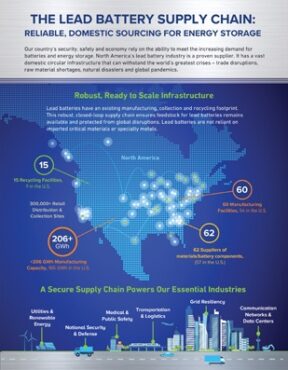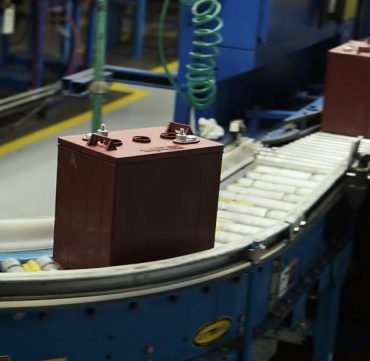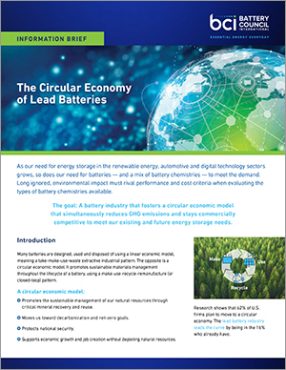
A Model of Resiliency and Reliability
The world is facing simultaneous crises that have disrupted supply chains globally. The lead battery industry’s circular domestic supply chain – a model of resiliency and reliability – is a proven exception.
Within North America, that circularity is ensuring a reliable supply chain for lead battery manufacturers that is not dependent on imports. For example, according to the U.S. Geological Service, U.S.-based recycling of used lead batteries and other lead-bearing scrap provided approximately 73% of the domestic demand for lead in 2019, of which new lead battery production accounted for 93% of use.
Lead Batteries Ensure Energy Storage is Available for Critical Applications
The story of lead batteries’ reliable supply chain is visually told in a new infographic that details how lead batteries’ vast, domestic, circular infrastructure can withstand the world’s greatest crises, from trade disruptions and natural disasters to a global pandemic.
Other Battery Technologies Rely on Foreign Supply Chains
In contrast, some critical minerals used in lithium-ion batteries, such as lithium, cobalt and graphite, are scarce. According to one scientific article, those minerals are not currently mined in large quantities or are mined in only a few countries whose trade policies could limit availability and impact prices.
Furthermore, lithium-ion batteries have only a 5% recycling rate. In the U.S., lead batteries have a 99% recycling rate. That helps mitigate climate change. According to a report from Sphera, “Comparative Life Cycle Assessment of Batteries for Automotive Applications,” the environmental impact of manufacturing lithium-ion batteries is six-times higher than the impact of manufacturing equivalent lead batteries. This is primarily due to a key advantage of lead batteries: 75% of the raw material in the battery is recycled lead, which also reduces environmental impact. In comparison, lithium batteries are currently manufactured using primarily raw materials, with no opportunity to recover battery grade materials at end-of-life.
Energy Storage Demand Reinforces Need for Sourcing Security
Lead battery sourcing security and sustainability couldn’t be timelier, according to Roger Miksad, executive vice president for Battery Council International. “As the need for grid resiliency, electrification and climate change mitigation grows, so does the need for safe, reliable energy storage. One recent survey reported that global battery demand is estimated to grow 110% over the next decade.”
Lead batteries are a key solution. An August 2020 issue of Science Magazine said “… perhaps the most unutilized potential of lead-acid batteries is electric grid storage, for which the future market is estimated to be on the order of trillions of dollars …”
Lead Battery Industry is Ready to Meet Demand
The lead battery industry has an existing infrastructure ready to scale to meet energy storage demands. There are 50 lead battery manufacturing facilities, more than 250,000 collection-distribution sites, and 13 recycling facilities in North America, as well as 92,000 U.S. jobs supported by the industry. Plus, more than 50 research projects are currently underway aimed at advancing innovation to create a next-generation lead battery.
In contrast, the concern for critical mineral supplies (such as those used in lithium-ion batteries) is so great that the U.S. government has made the security of such supplies a top priority. A bipartisan Critical Minerals Caucus was recently launched by Representatives Eric Swalwell (D-CA) and Guy Reschenthaler (R-PA) to focus on establishing a secure and reliable supply of rare earth elements and critical minerals to “end our dependence on foreign countries like China,” Reschenthaler said.
The Department of Defense (DOE) is also increasing its efforts to try to reduce our country’s dependence on imported critical materials by both reducing the amount of those materials needed for battery production and recycling spent materials already in use.
“As the demand for critical materials continues to grow, a secure and domestic upstream supply chain becomes vital,” said former Assistant Secretary for the Office of Energy Efficiency and Renewable Energy Daniel R. Simmons.
The DOE’s Energy Storage Grand Challenge (ESGC) launched last year has received bipartisan funding support from Congress to continue and expand under President Joe Biden. In addition, included in the Biden Build Back Better Recovery Plan is a call to invest deeply in battery technologies to secure America’s global energy leadership. In addition, a January 25 Executive Order supports manufacturers such as the lead battery industry, by ensuring that the federal government purchases American made goods by American workers though a Buy America program.
As the U.S. looks to reduce its reliance on foreign sources to meet our energy storage needs, lead batteries present a unique opportunity to leverage an existing, well-established domestic industry, without the need to develop source of raw materials, manufacturing, and recycling from scratch.
Lead Batteries: The Future of Energy Storage
As 2020 has shown, the ability to secure domestic feedstock of critical materials for manufacturing is beyond important. Our country’s security, safety, economy and sustainability rely on it. Lead batteries are leading the way with a circular domestic supply chain that models resiliency and reliability.








